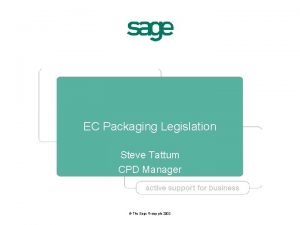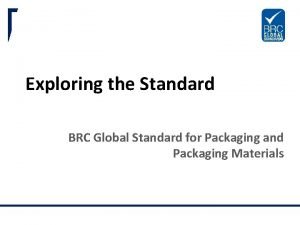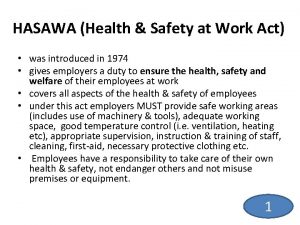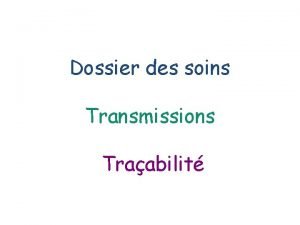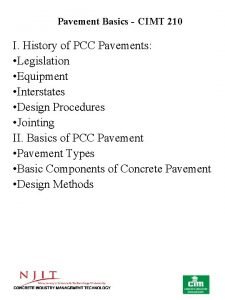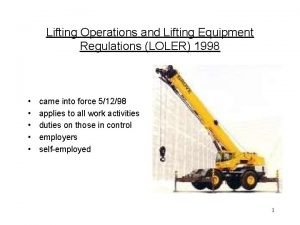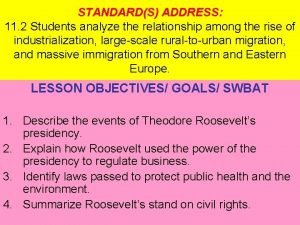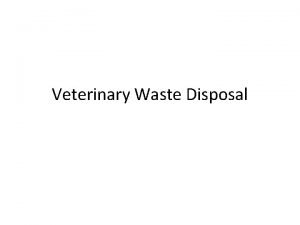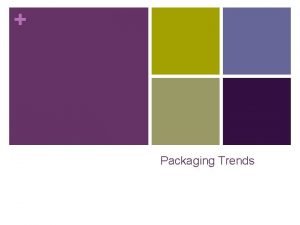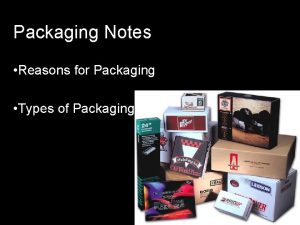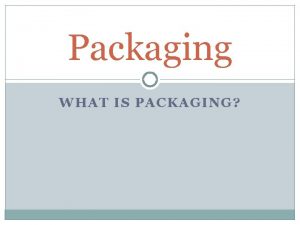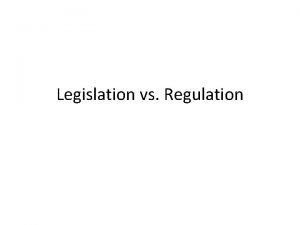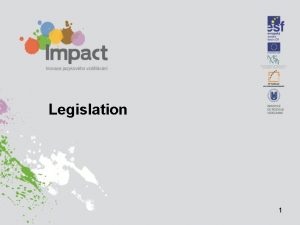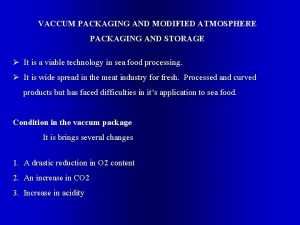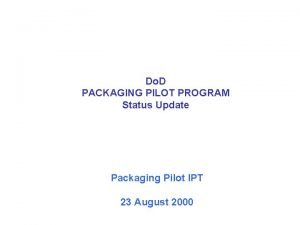EC Packaging Legislation Steve Tattum CPD Manager The


































- Slides: 34

EC Packaging Legislation Steve Tattum CPD Manager © The Sage Group plc 2002

EC Packaging Waste Directive Overview • • © The Sage Group Issues German Requirements UK Requirements Sage Enterprise’s Solution

EC Packaging Waste Directive Issues • • • EC legislation since 1994 Industrial & Domestic Waste Targets – By 2001 • • – By 2003 • • © The Sage Group 50% to 60% “recovery” 25% to 45% “recycled” 90% “recovery” 60% “recycled” Less than 10% disposed of in landfill Take-Back Systems across all EC states by 1998

EC Packaging Waste Directive Issues • • Optional “eco-taxes” by EC state Affects Manufacturers & Distributors – – – © The Sage Group Physical collection and sorting Reporting Self managed or 3 rd Party compliance schemes

EC Packaging Waste Directive German Requirements • • “Polluter-Pays” Principle 3 rd Party Compliance Scheme - “Duales System” Trade Mark “Der Grune Punkt” - Green Dot Collection Schemes – Kerb-side pickup • – Drop-off points • – Paper, cardboard, bottle banks Registration Fees by Type of Packaging • • © The Sage Group Aluminium, tinplate, plastics, drinks cartons Material fee (by weight) Item fee (by volume or surface area)

EC Packaging Waste Directive German Requirements • Monthly, Quarterly & Yearly Reporting of Usage – – – © The Sage Group Total quantity by pack type Total weight by material Total calculated fee

EC Packaging Waste Directive UK Requirements • • Variation of “Polluter-Pays” Spread Responsibility throughout Supply Chain – – • - 6% - 11% - 36% - 47% Transit Packaging – – © The Sage Group Raw material manufacturers Packaging manufacturers Pack fillers Sellers (to end consumer) “Secondary providers” Imported packaging - 83% - 100%

EC Packaging Waste Directive UK Requirements • 3 rd Party Compliance Schemes – • Obligation Thresholds – – • > £ 1 M turnover > 50 tonnes of packaging per year Interim Targets – – © The Sage Group Valpak, Difpak, Biffpak 1998 - Recovery 38%; Recycling 7% 1999 - Recovery 38%; Recycling 7% 2000 - Recovery 43%; Recycling 11% 2001 - Recovery 52%; Recycling 16%

EC Packaging Waste Directive UK Requirements • Yearly Reporting of Usage – Total recycle obligation by material • – Total recovery obligation (across all materials) • – – © The Sage Group Material Qty x Activity % x Recycle target % Material Qty x Activity % x Recovery target % By end of 1 st Quarter of following year Proven physical recovery by end of following year

EC Packaging Waste Directive Solution • • Single Generic Solution Retrospective Build of Pack Usage – Stock History File • • – New Entities • • • © The Sage Group Sales despatches Purchase receipts (imports) Activity Codes Material Codes Pack Codes Customer/Supplier Activity Overrides Customer/Supplier/Item Packing Structures Release - 2001

EC Packaging Waste Directive Solution • Packaging Detail Analysis Enquiry & Reporting – – © The Sage Group Quantities, Weights, Fees By Activity or Activity/Trading Partner By Material or Material/Trading Partner By Vol. /Area or Vol. /Area/Trading Partner

EC Packaging Waste Directive SES’s Solution (Phase 2) • Real-Time Pack Build/Entry – – • • © The Sage Group Order entry Despatch Packing Lists Pack Details on Despatch Documentation Support for Returnable Packaging Automated Recharging of Recovery Fees

Activity Codes © The Sage Group

Company Profile © The Sage Group

Links Between Packing Companies © The Sage Group

Volume/Surface area Codes © The Sage Group

Material Codes © The Sage Group

Packing Codes © The Sage Group

Packing Structures © The Sage Group

Partner Activity Override © The Sage Group

Partner Maintenance © The Sage Group

Entity Diagram D 1 1 Purchasing Order Processing Stock Transactions D 6 Customers D 7 Suppliers D 8 Structure Header D 9 Items Purchase Rec. Audit Trail D 2 Stock Audit Trail D 3 Sales Order Header D 4 Sales Order Detail D 5 Sub-contract History 2 Transaction Extract D 10 D 11 Pack Codes D 12 Materials D 13 Activities Transaction Extract 3 Pack Build D 14 Volume/Surface Area Codes D 15 Structure Detail D 16 Pack Extract Workfile D 17 4 Analysis Reporting © The Sage Group Pack Details Analysis

PACKAGING WASTE DEMO SYSTEM © The Sage Group plc 2002

Building a Demo System For ease of understanding, we will build a model based on cans of product packed in CASES of 12, shrink wrapped and labelled. The stock item is therefore a CASE. The stock item may be sold by CASE or by PALLET, comprising 48 CASES. © The Sage Group

Building a Demo System CAN 400 LABELLED CAN TRAY (12 CANS) SHRINK WRAPPED CASE © The Sage Group

Building a Demo System LABELLED CASE PALLET (48 CASES) © The Sage Group

Building a Demo System SHRINK WRAPPED PALLET DOGGY CHUNKS ||| |||||| © The Sage Group LABELLED PALLET

Building a Demo System © The Sage Group

Building a Demo System In this example, we have constructed a multi-level packing structure adding each packing code in turn. (We could simplify this by defining all the packaging for a CASE and setting up the appropriate material types and percentages, and then repeating the process for the PALLET packaging. ) We start by defining the packaging codes. © The Sage Group

Building a Demo System F 11 Materials - specify the make up of this Packaging Code © The Sage Group

Building a Demo System We now need to link the Stock item and packaging codes together. Note that a ‘many to one’ structure is not possible. © The Sage Group

Building a Demo System The stock item is 1 CASE of DC DOGGY_CHUNKS comprising 12 labelled cans on a tray, shrink wrapped and then labelled. The input quantity is 1/12 = 0. 083 of a CASE with minimum output of 12. I. e. Quantity / Layer x Minimum Output = No. of layers © The Sage Group

Building a Demo System © The Sage Group

Building a Demo System There are 48 cases on a pallet. By defining the minimum output of the previous stage in the packing structure as 48, we ensure that further levels of packing are only used when more than 48 cases are sold. I. e. Wooden Pallets, shrink wrap and pallet labels are not used when less than 48 cases are sold © The Sage Group
 Steve tattum
Steve tattum Brc packaging
Brc packaging Steve jobs, steve wozniak, and ronald wayne
Steve jobs, steve wozniak, and ronald wayne Senior manager vs general manager
Senior manager vs general manager Portfolio manager synergy manager parental developer
Portfolio manager synergy manager parental developer Iso legislation update
Iso legislation update Hasawa health and safety
Hasawa health and safety Forensic pharmacy
Forensic pharmacy Tourism law thailand
Tourism law thailand Tourism legislation and professinal ethics
Tourism legislation and professinal ethics Legis meaning
Legis meaning Delegated legislation meaning
Delegated legislation meaning Role of rrrlf in promotion and development of libraries
Role of rrrlf in promotion and development of libraries Traçabilité des soins infirmiers législation
Traçabilité des soins infirmiers législation Eu audit legislation
Eu audit legislation Mike hadley
Mike hadley Contraction joint in concrete
Contraction joint in concrete Types of legislation
Types of legislation Ict ethics and legislation
Ict ethics and legislation Aviation legislation module 10 ppt
Aviation legislation module 10 ppt Hierarchy of legislation
Hierarchy of legislation Examples of informal amendments
Examples of informal amendments Legislation vs regulation
Legislation vs regulation Health and safety legislation
Health and safety legislation Legislation related to maternity benefits
Legislation related to maternity benefits Loler 1998 legislation
Loler 1998 legislation What steps did roosevelt take to solve each problem?
What steps did roosevelt take to solve each problem? National policy and legislation related to child health
National policy and legislation related to child health Environmental legislation in construction
Environmental legislation in construction Veterinary waste disposal
Veterinary waste disposal Từ ngữ thể hiện lòng nhân hậu
Từ ngữ thể hiện lòng nhân hậu Bổ thể
Bổ thể Tư thế ngồi viết
Tư thế ngồi viết V cc cc
V cc cc 101012 bằng
101012 bằng
